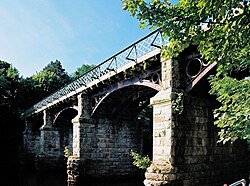North Western Railway
The North Western Railway (NWR) was a railway company in north west England. The company was given the unofficial addition " Little " to distinguish it from the larger London and North Western Railway (LNWR).
The NWR was taken over by the Midland Railway (MR), which used parts of the route network for their connection from London to Scotland via the Settle and Carlisle Line .
The main route of the NWR ran from Skipton to Morecambe and thus connected the MR with its rival the LNWR after the takeover.
The section between Lancaster and Morecambe was a test track for the electrification of the railroad in the early 20th century and was originally operated by the Morecambe Harbor and Railway .
Today sections of the route in West Yorkshire are mainly used; in Lancashire , many sections of the route that are now used as cycle and footpaths were dismantled.
history
The North Western Railway was founded on June 26, 1846 to build a railway from Skipton on the Leeds and Bradford Extension Railway to Low Gill on the Lancaster and Carlisle Railway , which should allow rail traffic from Yorkshire to Scotland. A connection from Clapham to Lancaster was also planned.
Originally planned as the main line, the connection from Skipton to Ingleton was opened on July 31, 1849 . An economic crisis caused the NWR to postpone the construction of the line to Low Gill and instead concentrate on a connection to Lancaster. A first section from Lancaster Green Ayre to Wennington was opened on November 17, 1849 . It was connected to the Skipton route via Bentham and Clapham on June 1, 1850 .
With the completion of the connection between Morecambe and Skipton, the connection from Clapham to Ingleton was closed after only 10 months of operation, as there was little hope of continuing the connection via Low Gill.
Morecambe Harbor and Railway
The Morecambe Harbor and Railway Company (MH&R) was founded on July 16, 1846 to build a port on Morecambe Bay near Poulton-le-Sands and to provide a rail link to Lancaster Green Ayre . The railroad opened on June 12, 1848 . On December 18, 1849 , a connection to the Lancaster and Carlisle Railway and Lancaster Castle station was established within Lancaster .
The creation of the port and the railway led to the creation of a larger settlement around Poulton-le-Sands, which eventually took the name Morecambe .
MH&R was formally taken over by NWR shortly after it was founded, even if it remained legally an independent company until it was taken over by MR.
From June 1, 1852 , the route was used by the trains of the Midland Railway. From January 1, 1859 , NWR and MH&R were leased to MR and taken over by MR on July 30, 1874 .
Sections
Ingleton Branch
The route via Low Gill was eventually operated by Lancaster and Carlisle Railway with trains of the London and North Western Railway opened on September 16, 1861. The route ended on in Ingleton at the viaduct , where the Lancaster and Carlisle Railway and the North Western Railway opened a station at one end of the viaduct and passengers had to walk from one station to the other. It was not until 1862 that trains to and from the south were allowed to cross the viaduct and use the North Western Railway station.
Settle-Carlisle Line
Due to the problems in Ingleton, the MR decided to build its own line between Settle and Carlisle and thus have its own connection from London St Pancras station via Carlisle to Scotland to Glasgow St Enoch station . The section between Skipton and Settle Junction has been a main line since then and is still used today as a diversion for InterCity trains.
Heysham Harbor
In 1904 the Midland Railway opened the port in Heysham to replace the port in Morecambe. On September 1, 1904 , the route was opened for passenger traffic, after having been open to freight traffic since November 12, 1898 .
electrification
The railway line between Lancaster, Morecambe and Heysham was the first to be equipped with an electric overhead line . The line was electrified first from Heysham to Morecambe, then to Lancaster Green Ayre station and finally on September 14, 1908 to Lancaster Castle station. A power supply of 6.6 kV at 25 Hz was ensured from a power station in Heysham via a cable with a steel bow.
Between February 11, 1951 and August 17, 1951 , the line was temporarily used by steam locomotives, because the overhead line was the first to be upgraded to 6.6 kV at 50 Hz during this time.
Closings
The Ingleton Branch ceased passenger services on January 30, 1954 and was then only occasionally used for freight transport and excursions. The line was finally closed on July 26, 1966 and the rails dismantled.
Operations on the section between Morecambe and Heysham ceased on October 4, 1975 , but was resumed on May 11, 1987 and has since ensured a connection to ferry connections to the Isle of Man .
Special structures
The railway bridge built by Edmund Sharpe over the River Lune near the Crock o 'Lune is now a Grade II protected cultural monument.
gallery
Bridge over the River Lune at Crook o 'Lune
Web links
- RAILSCOT: North Western Railway
- Eastern Railway Bridge over the River Lune at Crook of Lune on English Heritage Images of England
swell
- Anonymous (1953), "Modernization of North-West Lancashire Electrification", Railway Magazine, 99 (December 12, 1953), pp. 795-798, 804.
- C. Awdry, Encyclopaedia of British Railway Companies , Patrick Stephens Ltd, Wellingborough, 1990. ISBN 1-85260-049-7 .
- M. Bairstow, The 'Little' North Western Railway , Martin Bairstow, Leeds, 2000. ISBN 1-871944-21-X
- D. Binns, Railways Around Skipton , Wyvern Publications, Skipton, 1981.
- G. Suggitt, G., Lost Railways of Lancashire , Countryside Books, Newbury, (Reprint) 2004. ISBN 1-85306-801-2 .



